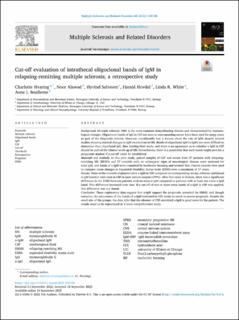| dc.contributor.author | Hvaring, Charlotte Maria | |
| dc.contributor.author | Alawad, Noor | |
| dc.contributor.author | Salvesen, Øyvind | |
| dc.contributor.author | Hovdal, Harald Olav | |
| dc.contributor.author | White, Linda Rosemary | |
| dc.contributor.author | Boullerne, Anne | |
| dc.date.accessioned | 2022-11-25T08:54:53Z | |
| dc.date.available | 2022-11-25T08:54:53Z | |
| dc.date.created | 2022-10-06T14:48:31Z | |
| dc.date.issued | 2022 | |
| dc.identifier.citation | Multiple Sclerosis and Related Disorders. 2022, 68 . | en_US |
| dc.identifier.issn | 2211-0348 | |
| dc.identifier.uri | https://hdl.handle.net/11250/3034029 | |
| dc.description.abstract | Background
Multiple sclerosis (MS) is the most common demyelinating disease and characterized by immunological changes. Oligoclonal bands of IgG in CSF not seen in corresponding serum have been used for many years as part of the diagnostic criteria. However, considerably less is known about the role of IgM, despite several studies showing marked changes to IgM metabolism in MS. Bands of oligoclonal IgM (o-IgM) are more difficult to determine than oligoclonal IgG, thus limiting their study, and there is no agreement as to whether o-IgM in CSF should be part of the clinical work-up of MS. Nevertheless, there is a possibility that such bands might provide a prognostic marker if a cut-off could be established.
Materials and methods
In this pilot study, paired samples of CSF and serum from 37 patients with relapsing-remitting MS (RRMS) and 57 controls with no subsequent signs of neurological disease were analysed for total IgM, and bands of o-IgM were visualised by isoelectric focusing and western blot. Patient records were used to compare mean changes in Expanded Disability Status Scale (EDSS) over a maximum of 17 years.
Results
None of the controls displayed extra o-IgM in CSF compared to corresponding serum, whereas additional o-IgM band(s) were seen in CSF in most patient samples (70%). After five years of disease, there was a significant difference in the EDSS between patients with no extra o-IgM compared to patients with at least one extra o-IgM band. This difference increased over time. If a cut-off of two or more extra bands of o-IgM in CSF was applied, this difference was not found.
Conclusion
These exploratory data suggest that o-IgM support the prognostic potential for RRMS, and though tentative, the occurrence of any bands of o-IgM restricted to CSF seems to result in poorer prognosis. Despite the small size of the groups, the data infer that the absence of CSF-restricted o-IgM is good news for the patient. The results need to be reproduced in a more comprehensive study. | en_US |
| dc.language.iso | eng | en_US |
| dc.publisher | Elsevier | en_US |
| dc.rights | Navngivelse 4.0 Internasjonal | * |
| dc.rights.uri | http://creativecommons.org/licenses/by/4.0/deed.no | * |
| dc.title | Cut-off evaluation of intrathecal oligoclonal bands of IgM in relapsing-remitting multiple sclerosis; a retrospective study | en_US |
| dc.title.alternative | Cut-off evaluation of intrathecal oligoclonal bands of IgM in relapsing-remitting multiple sclerosis; a retrospective study | en_US |
| dc.type | Peer reviewed | en_US |
| dc.type | Journal article | en_US |
| dc.description.version | publishedVersion | en_US |
| dc.source.pagenumber | 7 | en_US |
| dc.source.volume | 68 | en_US |
| dc.source.journal | Multiple Sclerosis and Related Disorders | en_US |
| dc.identifier.doi | https://doi.org/10.1016/j.msard.2022.104188 | |
| dc.identifier.cristin | 2059254 | |
| cristin.ispublished | true | |
| cristin.fulltext | original | |
| cristin.qualitycode | 1 | |

